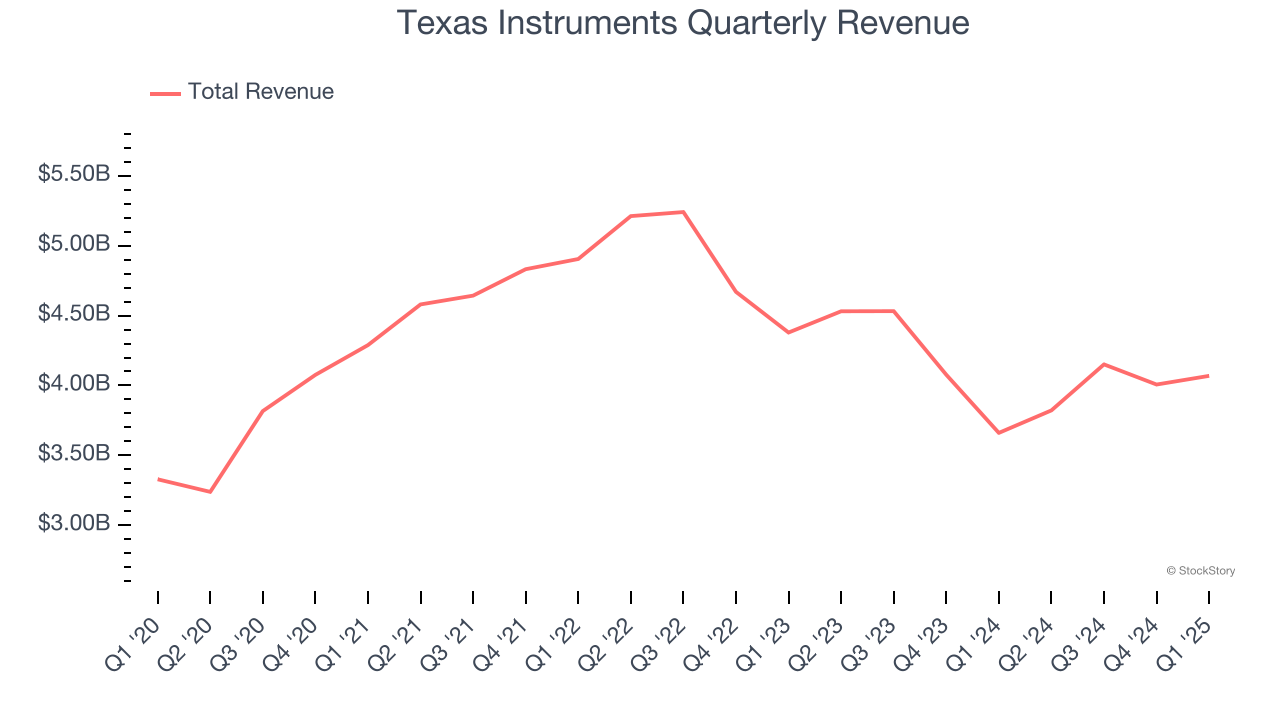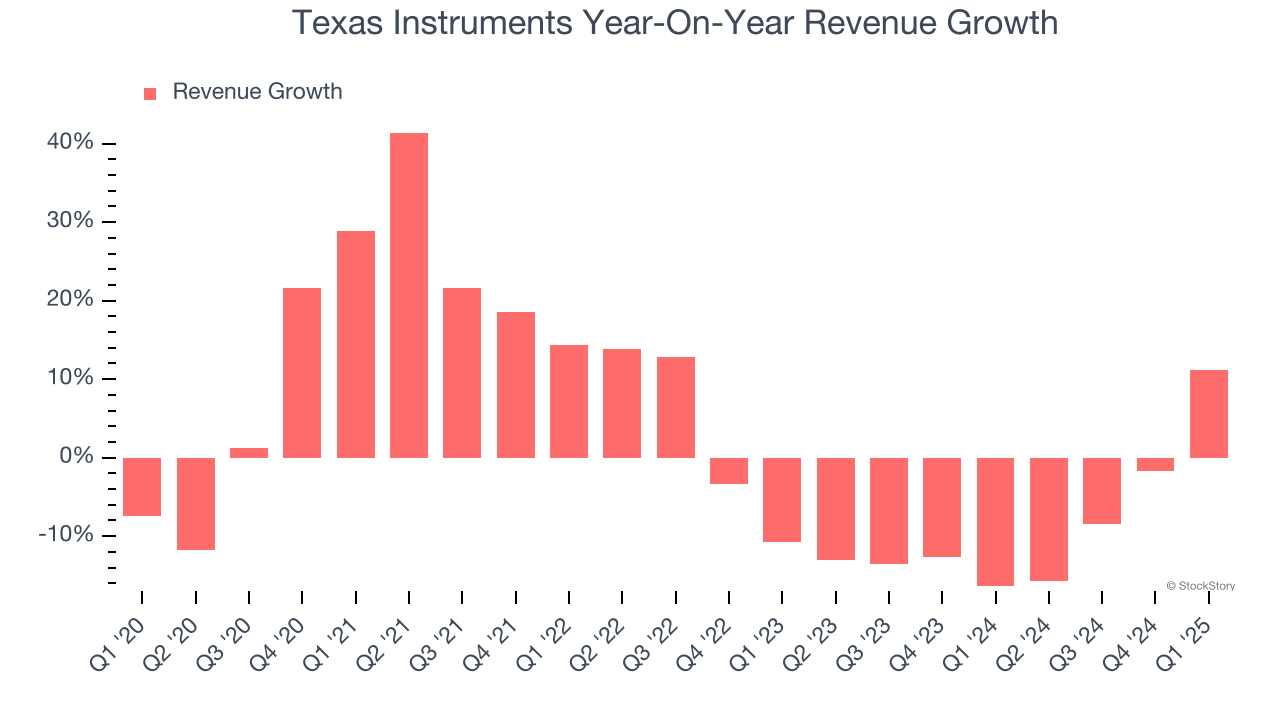
Analog chip manufacturer Texas Instruments (NASDAQ:TXN) reported Q1 CY2025 results topping the market’s revenue expectations, with sales up 11.1% year on year to $4.07 billion. On top of that, next quarter’s revenue guidance ($4.35 billion at the midpoint) was surprisingly good and 5.1% above what analysts were expecting. Its GAAP profit of $1.28 per share was 20.2% above analysts’ consensus estimates.
Is now the time to buy Texas Instruments? Find out by accessing our full research report, it’s free.
Texas Instruments (TXN) Q1 CY2025 Highlights:
- Revenue: $4.07 billion vs analyst estimates of $3.91 billion (11.1% year-on-year growth, 4.1% beat)
- EPS (GAAP): $1.28 vs analyst estimates of $1.06 (20.2% beat)
- Revenue Guidance for Q2 CY2025 is $4.35 billion at the midpoint, above analyst estimates of $4.14 billion
- EPS (GAAP) guidance for Q2 CY2025 is $1.34 at the midpoint, beating analyst estimates by 11.9%
- Operating Margin: 32.5%, down from 35.1% in the same quarter last year
- Free Cash Flow was -$14 million compared to -$231 million in the same quarter last year
- Inventory Days Outstanding: 243, in line with the previous quarter
- Market Capitalization: $133.5 billion
Company Overview
Headquartered in Dallas, Texas since the 1950s, Texas Instruments (NASDAQ:TXN) is the world’s largest producer of analog semiconductors.
Analog Semiconductors
Demand for analog chips is generally linked to the overall level of economic growth, as analog chips serve as the building blocks of most electronic goods and equipment. Unlike digital chip designers, analog chip makers tend to produce the majority of their own chips, as analog chip production does not require expensive leading edge nodes. Less dependent on major secular growth drivers, analog product cycles are much longer, often 5-7 years.
Sales Growth
A company’s long-term performance is an indicator of its overall quality. Any business can put up a good quarter or two, but the best consistently grow over the long haul. Over the last five years, Texas Instruments grew its sales at a sluggish 2.6% compounded annual growth rate. This was below our standards and is a poor baseline for our analysis. Semiconductors are a cyclical industry, and long-term investors should be prepared for periods of high growth followed by periods of revenue contractions.

We at StockStory place the most emphasis on long-term growth, but within semiconductors, a half-decade historical view may miss new demand cycles or industry trends like AI. Texas Instruments’s performance shows it grew in the past but relinquished its gains over the last two years, as its revenue fell by 9.3% annually. 
This quarter, Texas Instruments reported year-on-year revenue growth of 11.1%, and its $4.07 billion of revenue exceeded Wall Street’s estimates by 4.1%. Adding to the positive news, Texas Instruments’s growth inflected positively this quarter, news that will likely give some shareholders hope. Company management is currently guiding for a 13.8% year-on-year increase in sales next quarter.
Looking further ahead, sell-side analysts expect revenue to grow 9.1% over the next 12 months, an improvement versus the last two years. This projection is above average for the sector and suggests its newer products and services will fuel better top-line performance.
Here at StockStory, we certainly understand the potential of thematic investing. Diverse winners from Microsoft (MSFT) to Alphabet (GOOG), Coca-Cola (KO) to Monster Beverage (MNST) could all have been identified as promising growth stories with a megatrend driving the growth. So, in that spirit, we’ve identified a relatively under-the-radar profitable growth stock benefiting from the rise of AI, available to you FREE via this link.
Product Demand & Outstanding Inventory
Days Inventory Outstanding (DIO) is an important metric for chipmakers, as it reflects a business’ capital intensity and the cyclical nature of semiconductor supply and demand. In a tight supply environment, inventories tend to be stable, allowing chipmakers to exert pricing power. Steadily increasing DIO can be a warning sign that demand is weak, and if inventories continue to rise, the company may have to downsize production.
This quarter, Texas Instruments’s DIO came in at 243, which is 70 days above its five-year average, suggesting that the company’s inventory levels are higher than what we’ve seen in the past.

Key Takeaways from Texas Instruments’s Q1 Results
We were impressed by how significantly Texas Instruments blew past analysts’ EPS expectations this quarter. We were also glad its revenue guidance for next quarter exceeded Wall Street’s estimates. Zooming out, we think this was a good quarter with some key areas of upside. The stock traded up 5.3% to $159.85 immediately following the results.
Texas Instruments may have had a good quarter, but does that mean you should invest right now? We think that the latest quarter is only one piece of the longer-term business quality puzzle. Quality, when combined with valuation, can help determine if the stock is a buy. We cover that in our actionable full research report which you can read here, it’s free.
